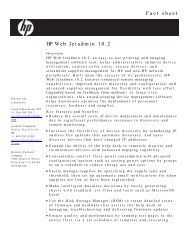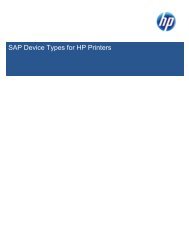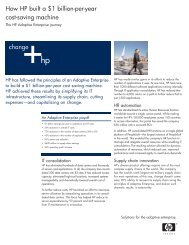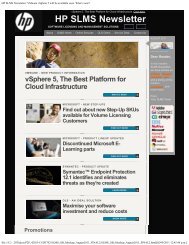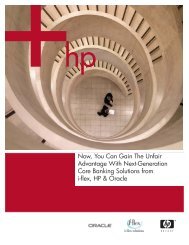CIMdata review on SAP's PLM cPDm program (PDF) - Large ...
CIMdata review on SAP's PLM cPDm program (PDF) - Large ...
CIMdata review on SAP's PLM cPDm program (PDF) - Large ...
You also want an ePaper? Increase the reach of your titles
YUMPU automatically turns print PDFs into web optimized ePapers that Google loves.
Each of these levels in the mySAP <strong>PLM</strong> product-structuring<br />
scheme builds <strong>on</strong> the capabilities of the lower<br />
level. This secti<strong>on</strong> describes each of these levels starting<br />
at the bottom (Material BOM Management) and working<br />
our way up to the top level (Sales C<strong>on</strong>figurati<strong>on</strong><br />
Engine). This organizati<strong>on</strong> is purely for ease of explanati<strong>on</strong><br />
and does not imply restricti<strong>on</strong>s in the usage of<br />
each of the modules.<br />
Material BOM Management<br />
When looking at a <strong>cPDm</strong> soluti<strong>on</strong>'s product structure<br />
management capabilities, many systems appear equivalent<br />
in their basic features. However, it is important<br />
to understand whether the capabilities offered are actually<br />
implemented within the soluti<strong>on</strong>, or if the soluti<strong>on</strong> is<br />
just a toolkit for the customer to use as a base to develop<br />
their own product structure management applicati<strong>on</strong>s.<br />
mySAP <strong>PLM</strong> provides solid product structuring capabilities<br />
in an applicati<strong>on</strong> built <strong>on</strong> the core SAP material<br />
BOM management capabilities. This comes from its<br />
ERP history, and allows mySAP <strong>PLM</strong> to offer <strong>on</strong>e of<br />
the most robust product structure management applicati<strong>on</strong>s<br />
available.<br />
Due to mySAP <strong>PLM</strong>'s background, the term and c<strong>on</strong>cept<br />
of a "part" is referred to in the mySAP <strong>PLM</strong> soluti<strong>on</strong><br />
as "material," however, to remain c<strong>on</strong>sistent in the<br />
<strong>cPDm</strong> industry we will c<strong>on</strong>tinue to use the term "part"<br />
in this assessment.<br />
mySAP <strong>PLM</strong> provides support for users to develop<br />
structures of parts (mySAP <strong>PLM</strong> material masters),<br />
routings, and documents. These structures can be related<br />
to each other and enable a given product to be fully<br />
defined. Users can browse either "down" the product<br />
structure, or "up" the structure as part of a "where<br />
used" evaluati<strong>on</strong>. Changes to product structures can be<br />
set through the use of date, serial, or parameter effectivity<br />
c<strong>on</strong>trols. Product structure modeling capabilities<br />
include:<br />
• Part (material master) revisi<strong>on</strong> levels – users can<br />
create and maintain multiple revisi<strong>on</strong>s of parts and<br />
BOMs through the ECN revisi<strong>on</strong> c<strong>on</strong>trol<br />
capabilities.<br />
• C<strong>on</strong>figurati<strong>on</strong> effectivity – effectivity is provided<br />
to manage the incorporati<strong>on</strong> of changes to the<br />
product structure. Date and serial effectivity can be<br />
used as well as user-defined parameters, and traceability<br />
support is provided to track these changes.<br />
• C<strong>on</strong>figurati<strong>on</strong> c<strong>on</strong>trol – product c<strong>on</strong>figurati<strong>on</strong>s can<br />
be defined and their effectivity managed in<br />
c<strong>on</strong>juncti<strong>on</strong> with the ECN and Workflow-driven<br />
processes. The ECN must be manually linked to<br />
each of the sub-assembly structures and each<br />
related document within the product structure.<br />
• Product opti<strong>on</strong>s, features, and variants – product<br />
opti<strong>on</strong>s, features, and variants can be defined, and<br />
grouped into valid c<strong>on</strong>figurati<strong>on</strong>s for product<br />
selecti<strong>on</strong> and packaging. Special "packages" can be<br />
defined that include combinati<strong>on</strong>s of sets of opti<strong>on</strong>s.<br />
These are referred to as variant c<strong>on</strong>figurati<strong>on</strong>s in<br />
mySAP <strong>PLM</strong>.<br />
The different variants of a c<strong>on</strong>figured product are<br />
identified using opti<strong>on</strong>s. Classificati<strong>on</strong> system characteristics<br />
can be used to define product features. The<br />
product opti<strong>on</strong>s include the possible values that can be<br />
used. mySAP <strong>PLM</strong> manages the dependencies between<br />
characteristics and values to allow validity checks to be<br />
carried out <strong>on</strong> proposed c<strong>on</strong>figurati<strong>on</strong>s.<br />
mySAP <strong>PLM</strong>'s capabilities to model and manage product<br />
c<strong>on</strong>figurati<strong>on</strong>s are a major strength of the soluti<strong>on</strong>.<br />
C<strong>on</strong>figurati<strong>on</strong> management can be provided through a<br />
combinati<strong>on</strong> of both modeling and management features.<br />
The system is fully integrated with the manufacturing<br />
capabilities of mySAP Supply Chain Management<br />
(mySAP SCM). Product and document structures can<br />
be displayed graphically, with full visibility of relati<strong>on</strong>ships<br />
through the product structure browser.<br />
Different revisi<strong>on</strong>s of parts, assemblies, and documents<br />
can be accessed. Different views of product structures<br />
can be displayed and browsed. These views are independent<br />
of each other. It is also possible to have <strong>on</strong>e<br />
master BOM with different views, such as "engineering"<br />
or "manufacturing" views. A flag <strong>on</strong> the BOM<br />
item defines the applicability for a given view. These<br />
can include data held <strong>on</strong> the "relati<strong>on</strong>ships" between<br />
the parts and documents. An example of this is the<br />
"quantity" of comp<strong>on</strong>ents used in an assembly. This<br />
attribute is held <strong>on</strong> the relati<strong>on</strong>ship between the assembly<br />
and the called-out parts. This approach is good, and<br />
is utilized by all of the better <strong>cPDm</strong> soluti<strong>on</strong>s available<br />
today.<br />
In Engineer-to-Order businesses, BOMs can appear to<br />
be different for each sales order. This would result in a<br />
tremendous amount of new parts/assemblies being created<br />
over time, and maintenance would become costly<br />
and time-c<strong>on</strong>suming. In many cases, especially for<br />
sales orders, it is <strong>on</strong>ly required to change, for example,<br />
<str<strong>on</strong>g>CIMdata</str<strong>on</strong>g> Program Assessment SAP’s mySAP <strong>PLM</strong> Page 23




